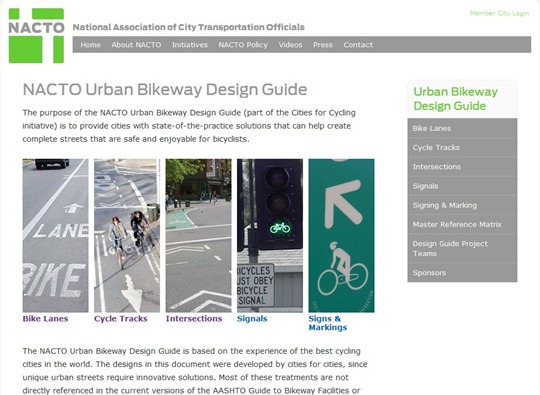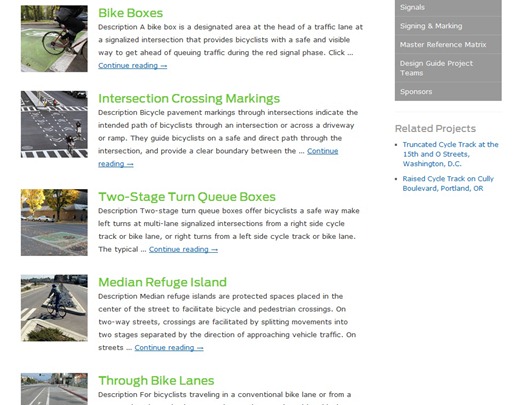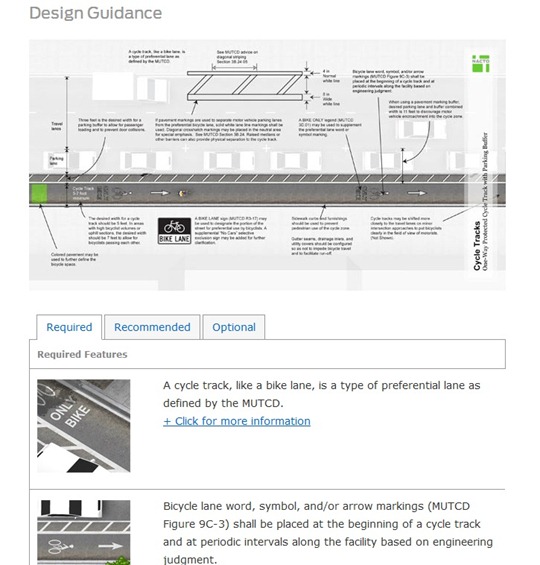
Last week at the National Bike Summit in Washington DC, the National Association of City Transportation Officials (NACTO) released its new online Urban Bikeway Design Guide. The bikeway design guide is an online resource providing cities with solutions to create complete streets that provide enhanced safety for bicyclists.
The design guide was unveiled by NYC DOT Commissioner Janette Sadik-Khan – who also serves as President of the NACTO.
From the design guide website:
The NACTO Urban Bikeway Design Guide is based on the experience of the best cycling cities in the world. The designs in this document were developed by cities for cities, since unique urban streets require innovative solutions.
To create the Guide, the authors have conducted an extensive worldwide literature search from design guidelines and real-life experience. They have worked closely with a panel of urban bikeway planning professionals from NACTO member cities, as well as traffic engineers, planners, and academics with deep experience in urban bikeway applications.
The website provides a clean, easy-to-read interface with the following high level bikeway design categories:
The top-level categories are broken down into different features:

Each feature provides a list of benefits, typical applications, design guidance (best practices), maintenance, and a list of U.S. cities that have adopted the particular feature.

There are plenty of great ideas in this design guide that are applicable to cities in North America.
NACTO has committed to update the content of the website as new best practices and features emerge.
Now if only we could get those ideas off the website and built in our cities tomorrow.
James D. Schwartz is the editor of The Urban Country. You can contact James at james.schwartz@theurbancountry.com
Related Articles:
- Bicycle Infrastructure Ignorance (Jan 2011)
- Ghettoize Me, Please (Jan 2011)
- Motorists Against Bicycle Infrastructure (Oct 2010)
- New York Bike Lanes Explained (Nov 2010)
- Dreaming of Segregated Bicycle Facilities (Dec 2010)


I’ve got two serious problems with this standard.
The first is that it is re-inventing the wheel. The Dutch CROW standard is the benchmark standard cycle facilities. Why waste time, money and resources trying to invent something else? See:
http://www.crow.nl/english
The second problem is that this is a really lousy standard.
Among other things, it endorses door zone bike lanes. Yes, road design where the most dangerous place on the entire road to ride a bicycle is in the bike lane.
“When placed adjacent to parking, a solid white line marking of four inch width should be used between the parking lane and the bike lane to minimise encroachment of parked cars into the bike lane.”
Note that “parking,” of course, refers to car parking. Bike parking? What’s that?
Or how about this little gem of a bike lane standard:
“The desirable ridable surface adjacent to a street edge or longitudinal joint is 4 feet, with a minimum width of 3 feet. In cities where illegal parking in bike lanes is an concern, 5 foot wide bike lanes may be preferred.”
A three foot wide bike lane? Elbow to elbow, I take three feet just riding. Guess what? There’s also got to be at least 1 1/2 feet of “swerve room” to safely avoid debris or obstacles. A three foot bike lane is a dangerous joke.
And just how is a five foot wide bike lane going to deter illegal car parking in bike lanes?
Instead of wasting large amounts of time, money and resources re-inventing the wheel they could have just used the Dutch CROW bicycle standards. Which, of course, do not allow door zone bike lanes or sub-standard bike lane widths.
RE: Bike Parking? It’s not addressed because we cyclists don’t park on the street.
Yes, colour the bike lanes, preferably yellow or yellow-striped. Drivers are hardwired to avoid areas of the roadway with yellow stripes. They don’t understand sharrows or bike boxes and will probably just ignore them.
Special signal lights? Cyclists will largely ignore them and they will piss off the motorists. (Do YOU always obey the pedestrain signals when you’re walking?)
A big NO to contra-flow or middle-of-the-road or left-side bike lanes. Stick to the right lane, people! Keep it simple. No reason for you to be anywhere else. This hearkens back to the bad advice we were given as kids to ride our bikes against the flow of traffic. I see enough wingnuts cycling in the wrong direction for their lane to know that traffic lane directions shouldn’t be confused any further.
And stick to riding single-file – the only reasons two people cycle abreast is so they can either chat or race. That should not be your priority on busy urban roads.
Anonymous – This video pretty much counters all of your points: http://www.youtube.com/watch?v=PpHeyjOzs9s
I’m the same ‘Anonymous’ who commented earlier. Of course, if you have bike lanes that are physically seperated from the car traffic (as all those lanes in the video are) you can make them go counter to the car traffic if you want since you have basically built a second roadway. But in Toronto in 2011, we have no such thing. By all means, let’s work to get them, but until that happy time comes we have to make do with what we have and that includes sticking to the right lane, not using cellphones while in motion, and riding single-file with the direction of the traffic… all common-sense safety measures.